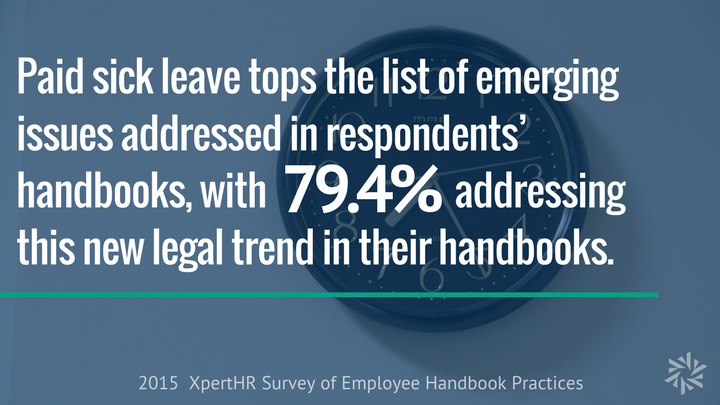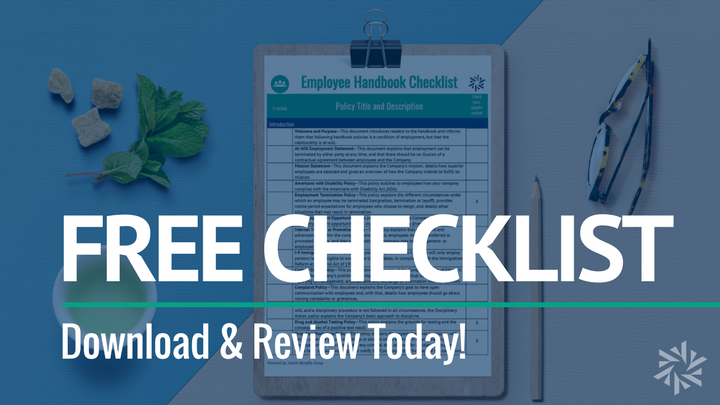Creating Your Employee Handbook
An employee handbook is an easy way to share important information to employees in a comprehensive manner. Employee handbooks provide company information for new employees, serve as a reference for seasoned employees, and ensures that all employees are treated equally with regard to your company policies and procedures, and can protect your company from potential lawsuits.
When creating a handbook for your company, draft it as a quick reference guide for employees. Generally, it is best to keep the document as short as possible while including all required and relevant policies for your company. Handbooks should be reviewed annually to ensure the policies and procedures are still relevant and up to date.

Employee Handbook Best Practices
Have your handbook reviewed by legal counsel to ensure it does not contain unlawful provisions or language that could be interpreted as creating an employment contract.
Make sure your handbook clearly states that it is not a contract and that the employment relationship is “at will” and can be ended at any time with or without cause.
Include a statement that your company has the right to revise policies at any time.
Include an effective date on each page of the employee handbook and include a statement that the current handbook replaces any previous handbook.
Require employees to sign a statement acknowledging that they have received the handbook and understand its provisions. Keep a copy in each employee’s personnel file.
Make sure that your handbook includes a list of offenses which are subject to discipline (but also note it is not a comprehensive list).
Include a section concerning equal employment opportunity and harassment.
General language gives you flexibility and allows your handbook to be changed easily.
Common trouble areas include policies on discipline/progressive discipline, layoffs, severance pay, probationary periods, performance evaluations, work rules and employee benefits. If you choose to include policies on these topics, legal counsel should carefully review them.
Make sure that the documentation within your organization is consistent.
Define the terms that you use, such as “excessive tardiness,” “insubordination,” etc.
Make sure supervisors understand that their discretion is limited and that they cannot modify the handbook. Consider supervisor training sessions on policies such as FMLA, ADA, harassment, employee discipline, interviews, etc.
Review your handbook annually to make changes and then have your legal counsel review those provisions. Give employees notice and have them sign off on significant changes.

Employee Handbook Checklist Overview
The following is a list of recommended sections for your employee handbook. Fill out the form to download our full Employee Handbook Checklist with detailed items for each recommended section.
Introduction: welcome message, at-will employment, mission, vision, etc.
Employment Policies: ADA, EEO, termination, promotion, etc.
Workplace Conduct: ethics, complaints, disciplinary action, harassment policy, drug-free workplace, etc.
Employee Benefits: employer-offered package, COBRA, wellness, etc.
Time Away from Work: PTO, flextime, illness, lunch and breaks, jury duty, FMLA, bereavement, vacation, voting, etc.
Information & Office Security: emergency action, facility access, visitors, computer usage, email, voicemail, cell phones, etc.
General Practices: anti-discrimination, attendance, background checks, company car, company credit card, business expenses, conflict of interest, direct deposit, dress code, employee fraternization, employee referral program, improper payment/gifts, media relations, open door policy, performance evaluation, overtime, personnel records, etc.
Appendix: forms required for previously mentioned policies, acknowledgements requiring signature, expense reports, etc.
Download our full Employee Handbook Checklist and don’t forget that Austin clients can request Employee Handbook assistance from their dedicated Account Manager. Contact us today to find out more about how Austin Benefits Group is simplifying HR!



